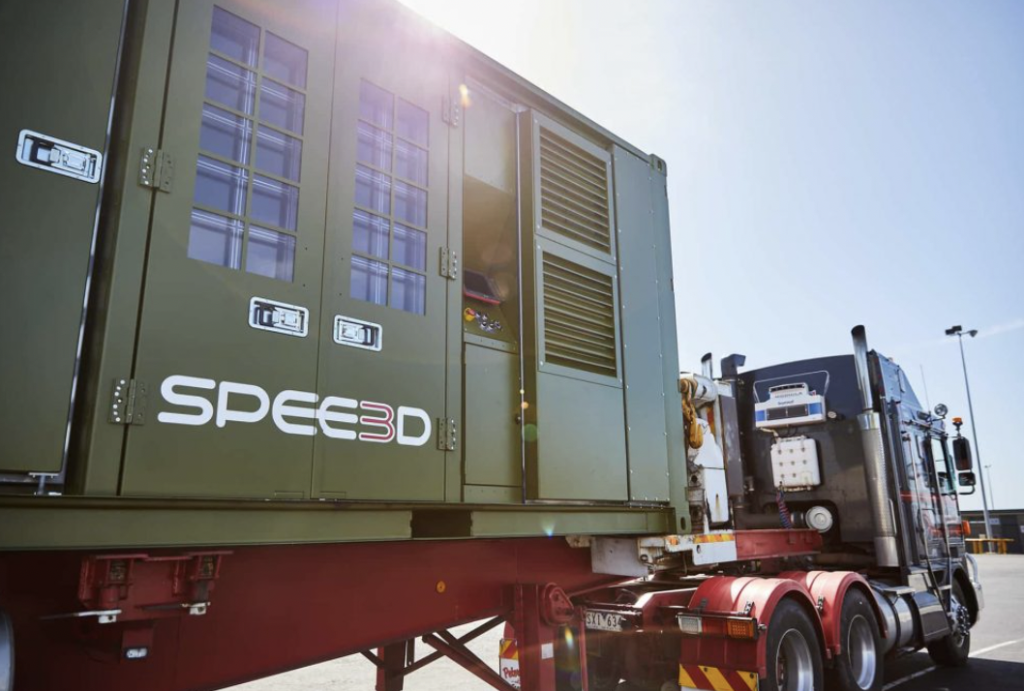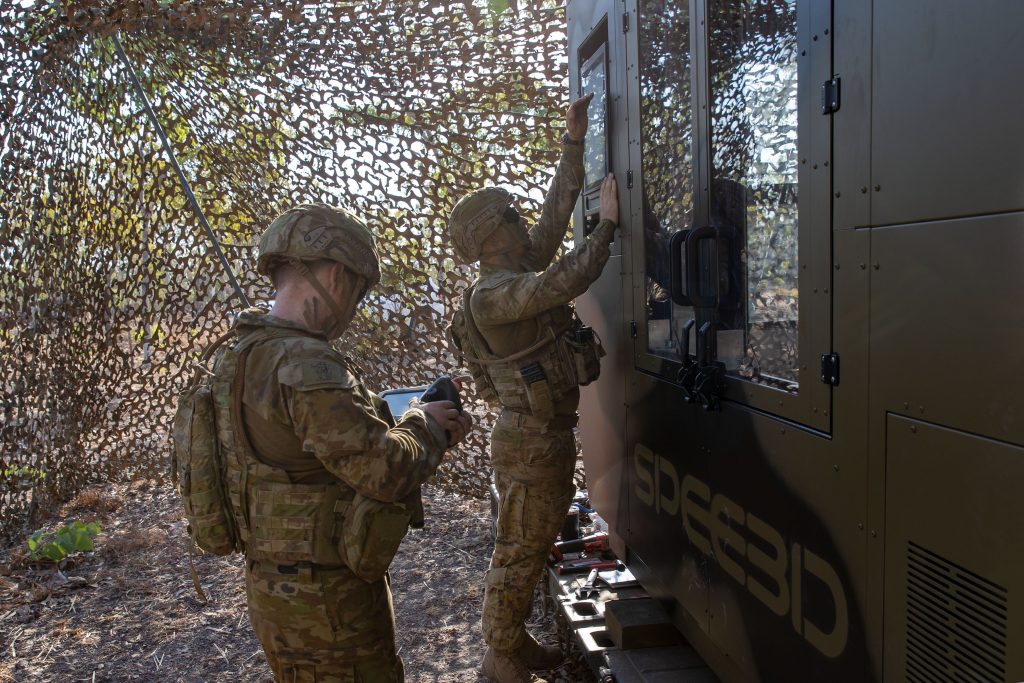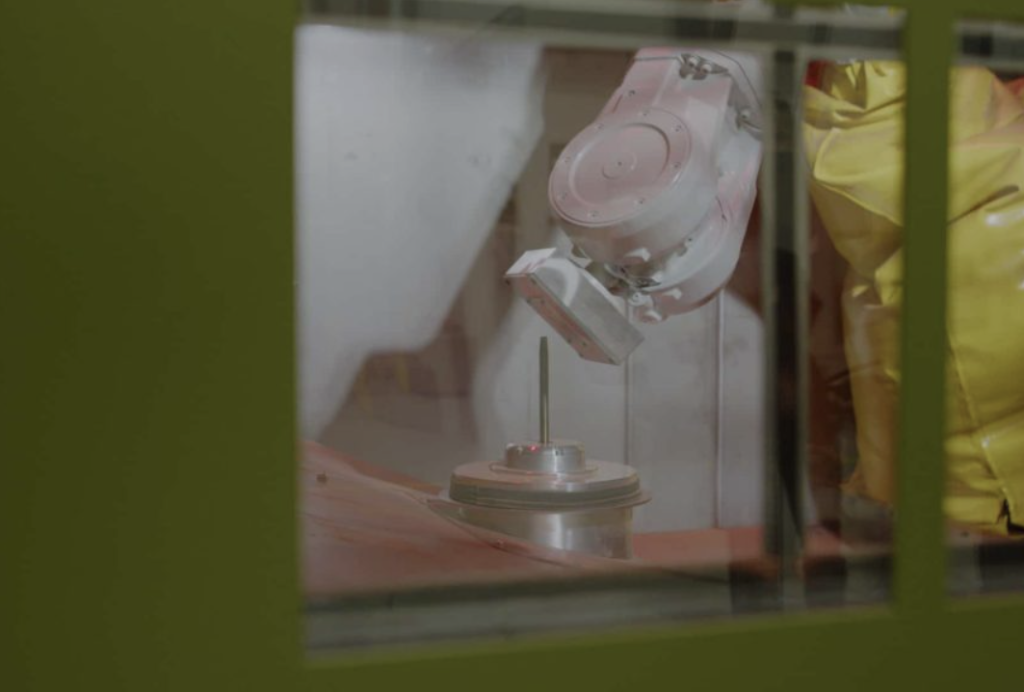Australian metal 3D printer manufacturer SPEE3D has announced the launch of a new containerized system, the ‘XSPEE3D.’
Designed to offer defense users a rapidly-deployable all-in-one metal 3D printing solution, the XSPEE3D comes with a printer and all the equipment needed to enter production, packed into a standard shipping container. Boasting a print speed “1,000 times faster” than its competitors, SPEE3D says the new ruggedized system is ideal for deploying in remote areas and producing inventory in the field.
“One of the most significant issues the military faces today is the ability to resolve critical spare part requirements in the field, a challenge that worsens in the face of global supply chain issues,” says SPEE3D CEO Byron Kennedy. “With the introduction of the XSPEE3D, we’re solving this issue with the ability to make reliable and affordable metal parts from anywhere, including in harsh, remote military field conditions.”
“We understand the operational, economic, and supply chain issues defense faces and look forward to continuing to work with them to help solve these challenges.”

Cold Spray 3D printing at SPEE3D
Kennedy co-founded SPEE3D alongside long-term business partner Steven Camilleri to tackle the difficulty the pair identified with producing metal parts quickly and at scale. The company’s offering revolves around its proprietary Cold Spray technology, which unlike ordinary metal 3D printers that fuse powder via lasers, jets particles onto a substrate with such energy, they fuse on impact instead.
Prior to the launch of the XSPEE3D, SPEE3D marketed its technology in the form of the LightSPEE3D and WarpSPEE3D, high-throughput machines, said to be between 100 and 1,000 times faster than traditional metal 3D printers.
Since launch, these systems have found applications ranging from on-demand part manufacturing to the production of rocket components. In early-2021 3D in Metal installed a WarpSPEE3D 3D printer at its El Salvador facility, enabling it to better meet Latin American demand. This was followed by the ‘SPAC3D’ rocket 3D printing project, which has seen SPEE3D awarded Australian government funding to develop high-quality, inexpensive engines for the nation’s aerospace sector.
The company’s Cold Spray technology has also gained traction in defense, with its systems being deployed on multiple test runs by the Australian Army. Following a string of Australian Army WarpSPEE3D 3D printing trials, the most recent of which saw it moved over 1,200km through rough terrain before deployment, Kennedy said the machine had demonstrated how it can “improve defense readiness.”

Prepping the XSPEE3D for action
According to SPEE3D, sourcing parts via global supply chains is “expensive and unreliable.” However, while supply chain instability continues to cause issues for businesses around the world, the firm has built the XSPEE3D primarily with defense users in mind. Out in the field, sourcing spares can be extremely difficult, thus SPEE3D’s system is designed to help military clients rapidly print them on-demand.
Housed in a 20-foot, 10-ton storage container, the XSPEE3D was developed alongside the Australian Army to ensure it’s as easy as possible to deploy and get up and running. Once shipped to location and powered up, the system is capable of printing at up to 100 grams per minute, and producing 1000mm x 700mm parts up to 40-kilos in weight.
Consequently, SPEE3D says its copper, nickel carbide, stainless steel and titanium compatible 3D printer allows users to go from design to finished part “in hours and days, not weeks or months.” As the firm’s tactical model, the XSPEE3D has also been ruggedized for usage in hostile environments. Not only can the unit be safely tipped to a 45-degree angle, but it’s faster to set up than its predecessors.
To facilitate the technology’s adoption in the defense sector, SPEE3D is working with the UK’s Manufacturing Technology Centre (MTC). According to Dr. Ken Young, Director of Technology at the MTC, which has close ties with military and defense organizations, the XSPEE3D’s ease of deployability could “open up a new area for additive manufacturing that until now has been unachievable.”
“Our goal at the MTC is to bridge the gap between industry and academia to showcase the world’s foremost technologies to our wide-ranging clients, including those in defense, and metal 3D printing is crucial for us to understand and teach them,” adds Young. “We chose the XSPEE3D for its unique capability to be deployed in harsh environments, which makes it ideal for military use, or for creation of spare parts in remote locations.”

Technical specifications and pricing
Below are the technical specifications for SPEE3D’s XSPEE3D 3D printer. Those interested in finding out more about the machine or getting hold of pricing information, can contact SPEE3D for a quote today.
| Maximum Part Size | ø 40” x 30” (approx) |
| Maximum Part Weight | 90lbs |
| Deposition Spot Size | 1/4” |
| Deposition Rate | up to 100g/minute |
| Noise | < 80dBA @1m (approx) |
| Footprint | 20ft. x 8ft. x 8.5ft. |
| Weight | 10 metric tons |
| User Interface | HMI Touch Screen |
| CAD Input Format | STL |
| Electrical Power Supply | 415V (3 phase), |
| 80A hard-wired connection |
Nominations for the 2022 3D Printing Industry Awards are now open. Who do you think should make the shortlists for this year’s show? Let us know by casting your vote now.
To stay up to date with the latest 3D printing news, don’t forget to subscribe to the 3D Printing Industry newsletter or follow us on Twitter or liking our page on Facebook.
While you’re here, why not subscribe to our Youtube channel? featuring discussion, debriefs, video shorts and webinar replays.
Are you looking for a job in the additive manufacturing industry? Visit 3D Printing Jobs for a selection of roles in the industry.
Featured image shows the XSPEE3D Cold Spray 3D printer. Photo via SPEE3D.



